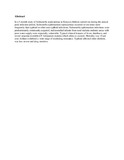| dc.contributor.author | Nesbitt, A | |
| dc.contributor.author | Mirza, NB. | |
| dc.date.accessioned | 2013-06-10T13:12:23Z | |
| dc.date.available | 2013-06-10T13:12:23Z | |
| dc.date.issued | 1989 | |
| dc.identifier.citation | Salmonella septicaemias in Kenyan children. Nesbitt A, Mirza NB. J Trop Pediatr. 1989 Feb;35(1):35-9. | en |
| dc.identifier.uri | http://www.ncbi.nlm.nih.gov/pubmed/2651690 | |
| dc.identifier.uri | http://erepository.uonbi.ac.ke:8080/xmlui/handle/123456789/30898 | |
| dc.description.abstract | In a 5-month study of Salmonella septicaemias in Kenyan children carried out during the annual peak infection period, Salmonella typhimurium septicaemias occurred seven times more frequently than typhoid or other non-typhoid infections. Salmonella typhimurium infections were predominantly community acquired, malnourished infants from rural malaria endemic areas with poor water supply were especially vulnerable. Typical clinical features of fever, diarrhoea, and severe anaemia resembled P. falciparum malaria which often co-existed. Mortality was 18 per cent. Isolates exhibited a wide range of multidrug resistance. Typhoid affected older children, was less severe and drug sensitive. | en |
| dc.language.iso | en | en |
| dc.title | Salmonella septicaemias in Kenyan children. | en |
| dc.type | Article | en |
| local.publisher | Medicine, University of Nairobi | en |

